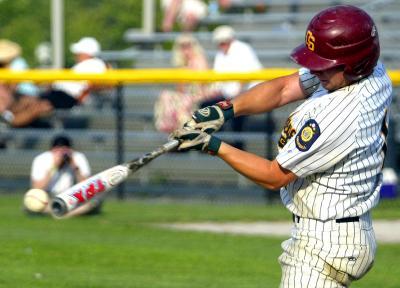The argument for using different bats in high school and the major leagues is primarily cost: wooden bats break when a fastball is hit too low on the bat.
But aside from skewing results for players - balls that would go nowhere due to a broken bat can be a hit using metal or composite bats - there is also a safety issue. For young players on defense, the ball can move much faster, because non-wood bats transfer energy to the ball better, a phenomenon called the "trampoline effect."
That makes the ball more dangerous. Such concerns have led to uniform bat regulations in college and high school baseball, but amid uncertainty about how non-wood bats perform in the hands of younger players, the rules are less consistent for that age group.

Most young baseball players use bats made from something other than wood. These bats are tightly regulated in high school and college but not younger kids. Credit: Mike Cohea/Brown University
"Everyone wants baseball to be safe and enjoyable," said biomechanic Glenn Fleisig, chair of the medical and safety advisory committee of USA Baseball, the nation's governing body for all amateur and youth baseball. "The time has come for us to have coordinated rules for bat performance in youth baseball, but the bat regulations for high school and up cannot be simply applied to youth baseball."
To create some real data, researchers at Brown recruited 22 volunteer hitters aged 13 to 18 to take about 3,400 swings with 13 different youth baseball bats. All of the non-wood bats tested were too light to be allowed in high school or college play.
Weight, energy and strength
At a given pitch speed, three independent factors influence the speed of a batted ball: the bat's mass and its distribution along its length, called the "moment of inertia" (MOI); the bat's degree of energy transfer, or its "trampoline effect"; and the speed of the swing, a consequence of the hitter's strength and biomechanics.
To measure these factors, the team set up a batting cage and a pitching machine in a Brown gym. They used an array of eight cameras shooting 300 frames a second to capture the complete motions of specially marked bats and balls. The video systems tracked the pitch speed, the bat speed, the ball speed and the place on the bat where the ball made contact.
Among the younger ballplayers in the study, lighter non-wood bats allowed them to swing somewhat faster than with wood, but the balls didn't go any faster, despite their higher trampoline effect. For these players, the much lower bat mass meant much less ball momentum overall.
"At the youth level for the bats that we studied, even though there was a trampoline effect, the loss of momentum overcompensated for it so no matter how hot the trampoline effect was, the bats were so light they still were not outperforming wood substantially," said Joseph "Trey" Crisco, professor of orthopaedics at Brown.
Among 13- to 15-year-olds, swing speed slowed significantly as bat mass increased, Crisco found. That meant that even the fastest-hitting bat was not as potent in the hands of the younger players as the older ones.
The non-wood bat that launched the ball fastest, called "Model A," had a weight and MOI that was on par with a light wood bat, but it had a much higher trampoline effect than the wood bats. The ball speed advantage it gave each hitter depended on the hitter's age. The 13-year-old players hit balls 7.4 miles an hour faster with model A than with the wood bats, but the 18-year-old hitters whacked the ball 11.6 miles an hour faster with model A (which they could never use in a real game), than with wood.
Although the study helps resolve the effect of the interplay between bat physics and batter biomechanics in youth baseball, the work of monitoring bats and their performance will likely continue.
"I think we have a very good handle on what's going on now with these bats," Crisco said. "The challenge is [that manufacturers] are going to come up with a new material and a new construction that our assumptions may or may not be valid for."
In other words, the bat goes on.






Comments